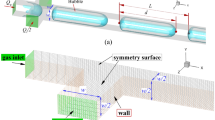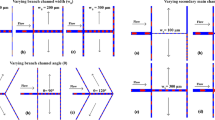Abstract
This paper aims at studying the asymmetrical breakup of bubbles at a microfluidic T-junction divergence stemming from the feedback effect of bubble behaviors at the T-junction convergence in a loop with the symmetrical branches by a high-speed digital camera. The experiments were performed under gas/liquid flow rates ratio ranging from 0.084 to 4.333. The microfluidic channels have uniform square cross-section with 400 μm wide and 400 μm deep. Four bubble behaviors (bubble pair asymmetrical collision, bubble pair staggered flow, single bubble flow and dynamic transformation flow) were observed at the T-junction convergence in different gas and liquid flow rates. The feedback effects of asymmetrical collision and staggered flow of bubble pairs at the T-junction convergence on bubble behavior at the T-junction divergence were mainly investigated. The result showed that the feedback effect is negligible at relatively low flow rates when no collision of bubble pairs occurs. And the bubble pair asymmetrical collision at T-junction convergence or an amplified effect of structured blemish of microchannel at relatively high flow rates is primarily responsible for the asymmetric breakup of bubbles at the T-junction divergence.










Similar content being viewed by others
References
Abate AR, Thiele J, Weitz DA (2011) One-step formation of multiple emulsions in microfluidics. Lab Chip 11:253–258
Baroud CN, Tsikata S, Heil M (2006) The propagation of low-viscosity fingers into fluid-filled branching networks. J Fluid Mech 546:285–294
Belloul M, Engl W, Colin A, Panizza P, Ajdari A (2009) Competition between local collisions and collective hydrodynamic feedback controls traffic flows in microfluidic networks. Phys Rev Lett 102:194502
Belloul M, Courbin L, Panizza P (2011) Droplet traffic regulated by collisions in microfluidic networks. Soft Matter 7:9453–9458
Bremond N, Thiam AR, Bibette J (2008) Decompressing emulsion droplet favors coalescence. Phys Rev Lett 100:024501
Calderon AJ, Fowlkes JB, Bull JL (2005) Bubble splitting in bifurcating tubes: a model study of cardiovascular gas emboli transport. J Appl Phys 99:479–487
Calderon AJ, Eshpuniyani B, Fowlkes JB, Bull JL (2010) A boundary element model of the transport of a semi-infinite bubble through a microvessel bifurcation. Phys Fluids 22:061902
Christopher GF, Bergstein J, End NB, Poon M, Nguyen C, Anna SL (2009) Coalescence and splitting of confined droplets at microfluidic junctions. Lab Chip 9:1102–1109
Cubaud T, Ho CM (2004) Transport of bubbles in square microchannels. Phys Fluids 16:4575–4585
Cybulski O, Garstecki P (2010) Dynamic memory in a microfluidic system of droplets traveling through a simple network of microchannels. Lab Chip 10:484–493
Fries DM, Trachsel F, von Rohr PR (2008) Segmented gas–liquid flow characterization in rectangular microchannels. Int J Multiph Flow 34:1108–1118
Fu T, Ma Y, Funfschilling D, Li HZ (2011a) Dynamics of bubble breakup in a microfluidic T-junction divergence. Chem Eng Sci 66:4184–4195
Fu T, Ma Y, Funfschilling D, Li HZ (2011b) Gas-liquid flow stability and bubble formation in non-Newtonian fluids in microfluidic flow-focusing devices. Microfluid Nanofluid 10:1135–1140
Fuerstman MJ, Garstecki P, Whitesides GM (2007a) Coding/decoding and reversibility of droplet trains in microfluidic networks. Science 315:828–832
Fuerstman MJ, Lai A, Thurlow ME, Shevkoplyas SS, Stone HA, Whitesides GM (2007b) The pressure drop along rectangular microchannels containing bubbles. Lab Chip 7:1479–1489
Gupta A, Kumar R (2010) Flow regime transition at high capillary numbers in a microfluidic T-junction: viscosity contrast and geometry effect. Phys Fluids 22:122001
Hou J, Qian G, Zhou X (2011) Gas–liquid mixing in a multi-scale micromixer with arborescence structure. Chem Eng J 167:475–482
Huang K-S, Lin Y-S, Yang C-H, Tsai C-W, Hsu M-Y (2011) In situ synthesis of twin monodispersed alginate microparticles. Soft Matter 7:6713–6718
Jose B, Cubaud T (2012) Droplet arrangement and coalescence in diverging/converging microchannels. Microfluid Nanofluid. doi:10.1007/s10404-011-0909-z
Jousse F, Farr R, Link DR, Fuerstman MJ, Garstecki P (2006) Bifurcation of droplet flows within capillaries. Phys Rev E 74:036311
Jullien MC, Tsang Mui Ching MJ, Cohen C, Menetrier L, Tabeling P (2009) Droplet breakup in microfluidic T-junctions at small capillary numbers. Phys Fluids 21:072001
Kamio E, Seike Y, Yoshizawa H, Matsuyama H, Ono T (2011) Microfluidic extraction of docosahexaenoic acid ethyl ester: comparison between slug flow and emulsion. Ind Eng Chem Res 50:6915–6924
Leshansky AM, Pismen LM (2009) Breakup of drops in a microfluidic T junction. Phys Fluids 21:023303
Lien K-Y, Liu C-J, Lin Y-C, Kuo P-L, Lee G-B (2009) Extraction of genomic DNA and detection of single nucleotide polymorphism genotyping utilizing an integrated magnetic bead-based microfluidic platform. Microfluid Nanofluid 6:539–555
Link DR, Anna SL, Weitz DA, Stone HA (2004) Geometrically mediated breakup of drops in microfluidic devices. Phys Rev Lett 92:054503
Luo R, Wang L (2011) Liquid velocity distribution in slug flow in a microchannel. Microfluid Nanofluid 12:581–595
Maddala J, Srinivasan B, Bithi SS, Vanapalli SA, Rengaswamy R (2011a) Design of a model-based feedback controller for active sorting and synchronization of droplets in a microfluidic loop. AIChE J. doi:10.1002/aic.12740
Maddala J, Wang WS, Vanapalli SA, Rengaswamy R (2011b) Drop traffic in microfluidic ladder networks with fore-aft structural asymmetry. arXiv:1111.5845v2
Mark D, Haeberle S, Roth G, von Stetten F, Zengerle R (2010) Microfluidic lab-on-a-chip platforms: requirements, characteristics and applications. Chem Soc Rev 39:1153–1182
Nisisako T, Hatsuzawa T (2010) A microfluidic cross-flowing emulsion generator for producing biphasic droplets and anisotropically shaped polymer particles. Microfluid Nanofluid 9:427–437
Parthiban P, Khan SA (2011) Filtering microfluidic bubble trains at a symmetric junction. Lab Chip 12:582–588
Prakash M, Gershenfeld N (2007) Microfluidic bubble logic. Science 315:832–835
Ralf S, Martin B, Thomas P, Stephan H (2012) Droplet based microfluidics. Rep Prog Phys 75:016601
Ransohoff TC, Radke CJ (1988) Laminar flow of a wetting liquid along the corners of a predominantly gas-occupied noncircular pore. J Colloid Interf Sci 121:392–401
Sessoms DA, Belloul M, Engl W, Roche M, Courbin L, Panizza P (2009) Droplet motion in microfluidic networks: hydrodynamic interactions and pressure-drop measurements. Phys Rev E 80:016317
Shao N, Gavriilidis A, Angeli P (2010) Mass transfer during Taylor flow in microchannels with and without chemical reaction. Chem Eng J 160:873–881
Sivasamy J, Wong TN, Nguyen NT, Kao LTH (2011) An investigation on the mechanism of droplet formation in a microfluidic T-junction. Microfluid Nanofluid 11:1–10
Smith BJ, Gaver DP (2010) Agent-based simulations of complex droplet pattern formation in a two-branch microfluidic network. Lab Chip 10:303–312
Stone HA, Stroock AD, Ajdari A (2004) Engineering flows in small devices: microfluidics toward a lab-on-a-chip. Annu Rev Fluid Mech 36:381–411
Talimi V, Muzychka YS, Kocabiyik S (2012) A review on numerical studies of slug flow hydrodynamics and heat transfer in microtubes and microchannels. Int J Multiph Flow 39:88–104
Thulasidas TC, Abraham MA, Cerro RL (1995) Bubble-train flow in capillaries of circular and square cross section. Chem Eng Sci 50:183–199
Timgren A, Trägårdh G, Trägårdh C (2009) Effects of cross-flow velocity, capillary pressure and oil viscosity on oil-in-water drop formation from a capillary. Chem Eng Sci 64:1111–1118
van Steijn V, Kreutzer M, Kleijn C (2007) μ-PIV study of the formation of segmented flow in microfluidic T-junctions. Chem Eng Sci 62:7505–7514
Wang A-B, Lin IC, Hsieh Y-W, Shih W-P, Wu G-W (2011) Effective pressure and bubble generation in a microfluidic T-junction. Lab Chip 11:3499–3507
Wörner M (2012) Numerical modeling of multiphase flows in microfluidics and micro process engineering: a review of methods and applications. Microfluid Nanofluid. doi:10.1007/s10404-10012-10940-10408
Zhao C-X, He L, Qiao SZ, Middelberg APJ (2011) Nanoparticle synthesis in microreactors. Chem Eng Sci 66:1463–1479
Acknowledgments
The financial supports for this project from the National Natural Science Foundation of China (Nos. 21106093, 20911130358), the Research Fund for the Doctoral Program of Higher Education (No. 20110032120010) and the Program of Introducing Talents of Discipline to Universities (Grant No. B06006) are gratefully acknowledged.
Author information
Authors and Affiliations
Corresponding author
Rights and permissions
About this article
Cite this article
Wu, Y., Fu, T., Zhu, C. et al. Asymmetrical breakup of bubbles at a microfluidic T-junction divergence: feedback effect of bubble collision. Microfluid Nanofluid 13, 723–733 (2012). https://doi.org/10.1007/s10404-012-0991-x
Received:
Accepted:
Published:
Issue Date:
DOI: https://doi.org/10.1007/s10404-012-0991-x




